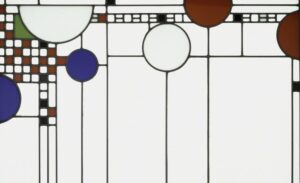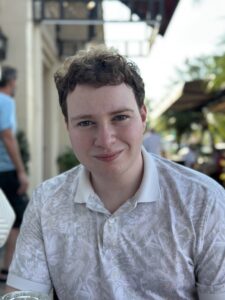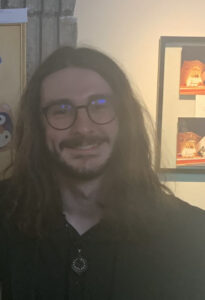 The Lafayette College
The Lafayette College
Contemporary Music Ensemble
Kirk O’Riordan, director
Friday April 28, 2023
8:00 pm
—Program—
Rain Tree Sketch II (1992)
Toru Takemitsu (1930 – 1996)
Manaka Gomi, piano
Dreams of the Wayfarer (2023)*
Zach Freiheiter (b. 2001)
I. Luminous Cove
II. Celestial Solstice
III. Golden Heist
Dan Wilkins+, solo alto saxophone
Owen York, piano
Jess Langlois, bass
Henry Pappas, drums
Emily Rice, clarinet
Olivia Hofmann, violin
Michala Dennis, violin
Maria Soukup, viola
Andreas Pelekis, cello
Kieran Ameres, cello
Kirk O’Riordan, conductor
Spark (2014)
Kala Pierson (b. 1977)
Rongman Xu, piano
Spiegel im Spiegel (1978)
Arvo Pärt (b. 1935)
Rebekah Fodale, violin
Manaka Gomi, piano
A Blue Twilight (2023)**
Brian Payne (b. 2001)
Brian Payne, electronics
Samantha Semsel, flute
Emily Rice, clarinet, bass
Maria Soukup, violin
Kieran Ameres, cello
Kirk O’Riordan, conductor
* World Premiere: Senior Capstone Project in Music
** World Premiere: Senior Honors Thesis in Music
+ Department of Music Faculty
Program Notes
Takemitsu: Rain Tree Sketch II
Takemitsu composed his Rain Tree Sketch II in 1992 in memory of Olivier Messiaen (1908-1992), the French composer who had a strong influence on Takemitsu. The work was composed for a concert “Hommage à Olivier Messiaen” at Les Semaines Musicales Internationales d’Orléans, France, and was premiered by Alain Neveux on 24 October 1992. The name of the work was probably inspired by a quotation from a novel by Kenzaburō Ōe about the miraculous rain tree, whose tiny leaves store up moisture and continue to let fall raindrops long after the rain has ceased. The work is also a dreamy meditation on the flow of life, and was the last piano piece by Takemitsu (his first Rain Tree Sketch was written in 1982). It is in a clear ternary (ABA) form, with a rhythmic opening which is reprised, in shortened form, after the melodic middle section. Its tonal language is reminiscent of Debussy and Messiaen, with chords used for colour and timbre rather than strict harmonic progressions, and, like its dedicatee, Takemitsu employs recurring motifs (such as an ascending three-note broken chord figure) and well-placed silences to create a carefully nuanced atmosphere and colouristic shadings. Directions such as “celestially light” and “joyful” contribute to the metaphysical nature of this work.
Notes by Frances Wilson. Read the full article here.
Freiheiter: Dreams of the Wayfarer
Dreams of the Wayfarer is a three movement saxophone concerto that combines classical form and structure with harmonic and rhythmic elements from jazz. The orchestration includes a jazz quartet with a solo alto saxophonist, and an orchestral section with clarinet, violin, viola, and cello. The three movements represent three different distinct styles of jazz with the first movement being a blues from the big band era influenced by Count Basie and Duke Ellington, a ballad that is reminiscent of the Great American Songbook, and lastly a modern jazz composition influenced by the melodies and harmonies of John Coltrane and McCoy Tyner.
Pierson: Spark
Spark is one of three pieces Pierson composed for Holly Roadfeldt as a part of her Preludes Project. Like Much of Pierson’s music, it celebrates calm, space, and silence. While not minimalist in the common understanding of the term, this piece focuses each gesture to a shining point, stripping away all that is not essential and leaving the listener enveloped in resonance.
Pärt: Speigel im Spiegel
Spiegel im Spiegel (Mirror in the Mirror) is one of the best known and most performed pieces by Arvo Pärt and also one of his last compositions before his departure from Estonia. In 1978, the renowned Russian violinist Vladimir Spivakov commissioned a piece from Pärt for violin and piano, and already in December of the same year he premiered it at the Moscow Conservatory with the pianist Boris Bekhterev.
The musical material of Spiegel im Spiegel is presented with utmost clarity and strictness. It only consists of the melody of the solo instrument and the three-note piano accompaniment. The structure of the piece follows a strict formula, where no note is left to chance. The title directly reflects what is happening in the music: each ascending melodic line is followed by a descending mirror phrase. Initially, the melody consists of only two notes, with another note being added with each of the following phrases, thus creating a seemingly endless continuum. After each distancing, the melody returns to the central pitch of A, which, according to the composer, is like “returning home after being away”. The piano part accompanies the melody part at each step like a “guardian angel”, as the composer himself likes to say. In addition to the accompaniment, the piano part includes tintinnabuli notes – like little bells that alternately sound above and below the melodic line, following a fixed formula.
This seemingly simple composition poses a great challenge to a musician in bringing the music alive during the performance. The composer believes that first and foremost, the musician has to have something to say to himself or herself and to others: “Everything redundant must be left aside. Just like the composer has to reduce his ego when writing the music, the musician too must put his ego aside when performing the piece.” Purity and innocence are the qualities valued by the composer in the performance of his music.
Spiegel im Spiegel is one of the works of which the composer as well as the musicians have created numerous versions for various instrument combinations. It has often been used in ballet and dance performances, films and documentaries and even in DJ remixes.
Notes courtesy of the Arvo Pärt Centre. Read the article here.
Payne: A Blue Twilight
A Blue Twilight was composed for Cello, Violin, Flute, Clarinet, and electronic playback throughout September 2022 to April 2023. This piece uses multiple musical languages, such as modal, tonal, contrapuntal, and free atonality to express the journey of a protagonist going on an adventure. The storythispiecefollowswaswritteninDecember2019.
The details of the story are left intentionally vague, allowing the listener to fill in their own details. The electronic playback will guide the listener through the various settings of the story, while leaving the events up to the listener.
The story of A Blue Twilight draws inspiration from many sources, such as cosmic horror, Romantic era program music, and Dungeons & Dragons.
Lafayette Composer Biographies
 Zach Freiheiter
Zach Freiheiter
is a Senior Music Major and Economics Minor from Randolph, New Jersey. He started playing trumpet in 2010, and saxophone in 2019. At Lafayette he has been involved with Concert Band, Jazz Combo, Jazz Ensemble, Percussion Ensemble, Pep Band, and Contemporary Music Ensemble. As well as all of the ensembles he is involved with he started his own band “LAN Party” in 2022 with the objective of introducing jazz to his generation through the medium of video game music. He started composing in 2020 after taking an introduction to composition class with Professor O’Riordan and has been studying jazz arrangement and composition with Charlie Rosen since August 2020.
At Lafayette he has had four pieces premiered so far: Bandit’s Lullaby, Iridescent Fantasy, The Dragon’s Cavern, and Forgotten Sanctuary. Zach will be attending William and Mary in the Fall to study a masters in accounting and will continue to be playing and composing while there.
 Brian Payne
Brian Payne
is a pianist and composer from Sugarloaf, PA. They are currently a senior Mathematics and Music double major. They are currently in Lafayette’s Mbira ensemble. A Blue Twilight is their honors thesis and they are looking forward to seeing the culmination of all the hard work both by them and the many others who helped make this piece possible.
About LCCME
The Lafayette College Contemporary Music Ensemble is comprised of some of the most experienced and accomplished instrumental performers at Lafayette College. Membership in the ensemble is by invitation of the director. The core instrumentation of the ensemble is Flute, Clarinet, Saxophone, Violin, Violoncello, Double Bass, Piano, and Percussion. Other instruments and players are added as required by the repertoire.
LCCME performs music by 20th- and 21st-century composers: established masters, emerging artists, and students. Now in its twelfth season, LCCME has premiered over 30 new pieces, all of which were composed specifically for–or by–the ensemble. LCCME has also performed music by master composers Arvo Pärt, John Cage, George Crumb, Karlheinz Stockhausen, Terry Riley, and others .It performs one-two concerts each academic year. The ensemble specializes in performing works by Lafayette student composers: among these are two chamber operas, works for electronics, music for film and multi-media, and numerous chamber ensembles. LCCME regularly incorporates electronics, improvisation, video, lighting, and theatrical elements into its programs.
Composition at Lafayette
Students who wish to study composition at Lafayette typically begin their work with the Music Theory sequence of courses, often culminating with MUS 324: 20th Century Harmonic Practice. At some point in that sequence a student will take MUS 249: Introduction to Composition, and its sequel, MUS MUS 325, Composition Seminar. Courses in Orchestration, electronic music, and other relevant topics are available, and students may also take private lessons.
Composition students often pursue capstone or Thesis work. Below is a list of students who have completed these kinds of projects:
Brian Payne ’23: A Blue Twilight for Chamber Ensemble and Electronics
Zach Freiheiter ’23: Dreams of the Wayfarer for Solo Alto Saxophone, Jazz Combo, and Strings
Justin Kogasaka ’22: Stolen Time for Chamber Orchestra
Anna Zittle ’22: Missed: A Chamber Opera in One Act
Eric Gourdon ’20: Leaving Port on a Shimmering Sea for Chamber Orchestra
Ashley Kushner ’19: Would I Have Broke the Happy Dream for Wind Ensemble
Marcus Salvadore ’19: Thoughts for Marimba and Live Electronics
Johnny Gossick ’18: Lecture/Demonstration in Live Coding
Sam Friedman ’11: Adagio Anteros for Chamber Orchestra
(Honors Thesis)
Opportunities for hearing performances of their works is critical for composers. In addition to public performances given by Music Department ensembles such as The Lafayette College Concert Band, Chamber Orchestra, Percussion Ensemble, and Contemporary Music Ensemble (which has performed over 30 student works), student composers have participated in reading sessions with HUB New Music and SO Percussion and in master classes with visiting composers Augusta Read Thomas, Michael Torke, Gregory Wannamaker, Anthony Lanman, Stephanie Ann Boyd, and Andrea Clearfield.